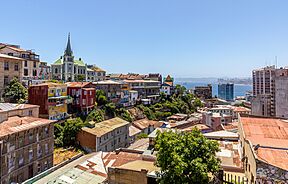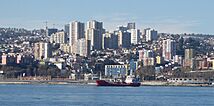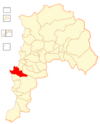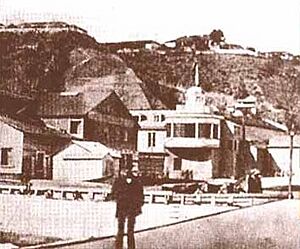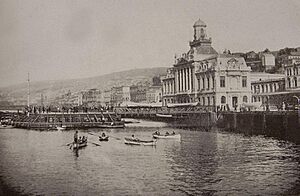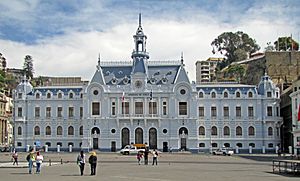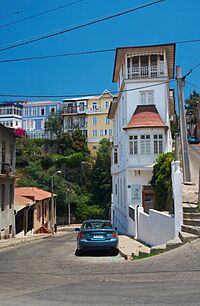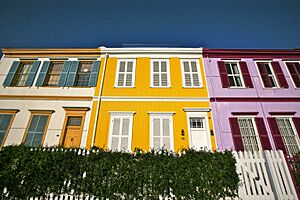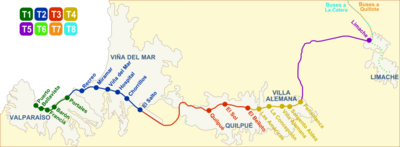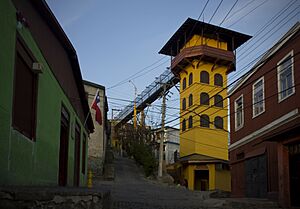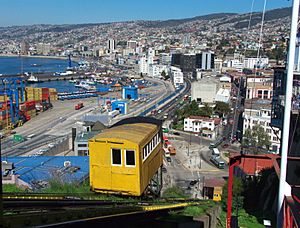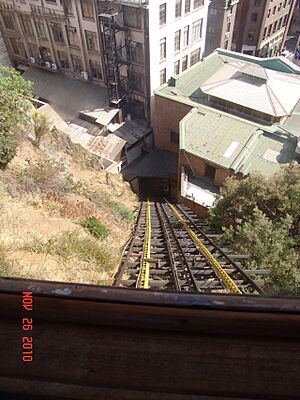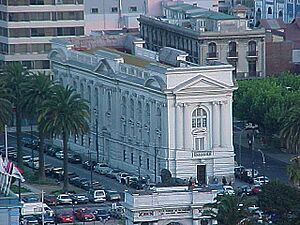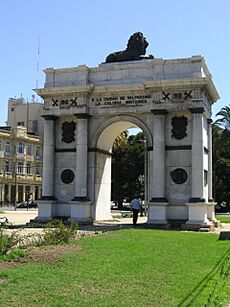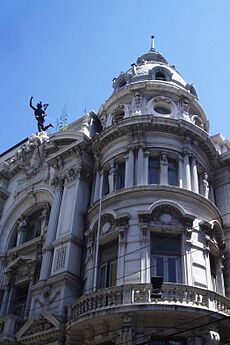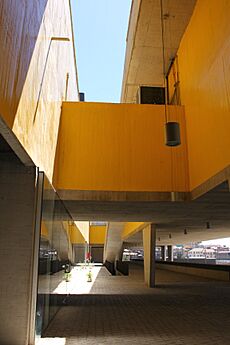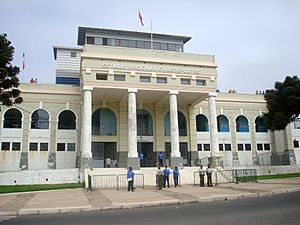Valparaíso facts for kids
Quick facts for kids
Valparaíso
|
||||||
|---|---|---|---|---|---|---|
|
The historic quarter with the Lutheran Church on the left
Edificio Armada de Chile
Iquique Heroes Monument
Artillería funicular
Matriz Church
La Sebastiana
Cityscape as seen from the sea
|
||||||
|
||||||
| Nickname(s):
The Jewel of the Pacific, Valpo
|
||||||
| Country | ||||||
| Region | Valparaíso | |||||
| Province | Valparaíso | |||||
| Founded | 1536 | |||||
| Named for | Valparaíso de Arriba, Spain | |||||
| Capital | Valparaíso | |||||
| Government | ||||||
| • Type | Municipality | |||||
| Area | ||||||
| • City | 401.6 km2 (155.1 sq mi) | |||||
| Elevation | 10 m (30 ft) | |||||
| Population
(2012 census)
|
||||||
| • City | 284,630 | |||||
| • Density | 708.74/km2 (1,835.63/sq mi) | |||||
| • Urban | 275,141 | |||||
| • Metro | 930,220 | |||||
| • Rural | 841 | |||||
| Demonym(s) | Porteño (m), Porteña (f) | |||||
| GDP (PPP, constant 2015 values) | ||||||
| • Year | 2023 | |||||
| • Total (Metro) | $28.7 billion | |||||
| • Per capita | $28,500 | |||||
| Time zone | UTC−4 (CLT) | |||||
| • Summer (DST) | UTC−3 (CLST) | |||||
| Area code(s) | (country) 56 + (city) 32 | |||||
| Climate | Csb | |||||
Valparaíso is a big city, commune, and seaport in Valparaíso Region, Chile. It's also an important naval base.
The Greater Valparaíso area is the second largest in Chile. Valparaíso itself is the second largest city in this area, after Viña del Mar. The city was named after a village in Spain called Valparaíso de Arriba. It is about 120 kilometers (75 miles) northwest of Santiago. Valparaíso is one of the most important seaports on the Pacific Ocean. It is the capital of Chile's second most populated region. Since 1817, it has been the main home for the Chilean Navy. Also, the Chilean National Congress has been located here since 1990.
In the late 1800s, Valparaíso was very important for ships traveling between the Atlantic and Pacific oceans. These ships used the Straits of Magellan. The city grew quickly during this "golden age" and attracted many European immigrants. Sailors called it "Little San Francisco" and the "jewel of the Pacific". During this time, Valparaíso got Latin America's oldest stock exchange, the first volunteer fire department in the continent, Chile's first public library, and the world's oldest Spanish language newspaper still being printed, El Mercurio de Valparaíso. In 2003, the historic part of Valparaíso became a UNESCO World Heritage Site.
The 1900s were harder for Valparaíso. Many rich families left the city. When the Panama Canal opened in 1914, fewer ships stopped in Valparaíso. This hurt the city's shipping and port economy. By the 2000s, the port of San Antonio handled more trade than Valparaíso. This made people question if Valparaíso was still Chile's "principal port."
From 2000 to 2015, the city started to recover. Artists, tourists, and people who wanted to start cultural businesses moved there. They loved the city's historic hillside areas. Today, thousands of people visit Valparaíso every month. They come from Chile and other countries to see its maze of cobblestone streets and colorful buildings. The Port of Valparaíso is still a big center for shipping containers, copper, and fruit. It also gets more and more cruise ships during the South American summer. Most importantly, Valparaíso has become a major center for education and fun. It has four large traditional universities and several big vocational colleges.
Valparaíso is known for its artisans and bohemian culture. It is also famous for its music festivals and art events. The biggest and most well-known is the yearly Viña Del Mar International Song Festival. This festival is usually held in March in a large amphitheater that can hold 40,000 people. "Viña" helps the region's economy a lot. It usually sells out, and thousands of people travel to the city for it. The festival shows many different performers and gives out prizes. It is shown on TV and online around the world. Famous musicians from both Spanish- and English-speaking countries often perform there.
Contents
- A Look at Valparaíso's Past
- Valparaíso in the 19th Century
- Valparaíso in the 20th Century
- Valparaíso Today: 21st Century
- Valparaíso's Location and Weather
- Exploring Valparaíso's Cityscape
- Who Lives in Valparaíso?
- Valparaíso's Economy
- Getting Around Valparaíso
- Valparaíso's Culture
- Sports in Valparaíso
- Education in Valparaíso
- Famous People from Valparaíso
- Sister Cities of Valparaíso
- See also
A Look at Valparaíso's Past
The Bay of Valparaíso was first home to the Picunche people, who were known for farming. In 1536, Spanish explorers arrived on a ship called the Santiaguillo. This ship brought men and supplies for an expedition. The leader, Juan de Saavedra, named the town after his home village in Spain.
During the time Spain ruled Chile, Valparaíso was a small village. It was sometimes attacked by English pirates like Francis Drake in 1578.
In 1810, a rich merchant built the first pier in Chile. This helped the city's port grow. After Chile became free from Spain in 1818, Valparaíso became the main harbor for the new Chilean navy. It also opened up trade with other countries.
Valparaíso quickly became a popular stop for ships sailing around South America. This was especially true during the California Gold Rush (1848–1858). Many immigrants from Europe came to Valparaíso, especially from Britain, Germany, France, Switzerland, and Italy. They spoke their own languages and even started newspapers in them.
The British community grew strong in Valparaíso between the 1820s and 1920s. They started businesses and settled in areas like Cerro Alegre. They also helped create the first volunteer firemen's association in 1851 and the first telephone service in 1880.
International immigration changed the local culture. Immigrants built the first non-Catholic cemetery in Chile. Football (soccer) was brought to Chile by English immigrants. French immigrants started the first private Catholic school. Buildings in Valparaíso showed many different European styles.
On August 18, 1906, a big earthquake hit Valparaíso. It caused a lot of damage and thousands of deaths. A Chilean doctor, Carlos Van Buren, helped the victims. He later started a hospital named after him.
Valparaíso's "golden age" of trade ended when the Panama Canal opened in 1914. Ships started using the canal to avoid the long and risky trip around South America. This caused the port's use and traffic to drop a lot. However, in recent decades, shipping has increased again. This is due to fruit exports and larger ships that don't fit through the Panama Canal.
Valparaíso in the 19th Century

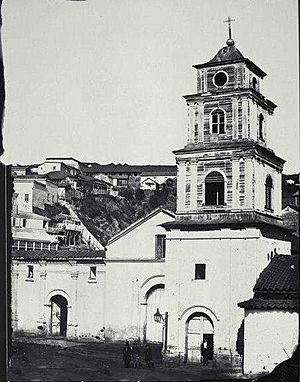
On March 28, 1814, the USS Essex was defeated by British ships during the War of 1812. This battle happened offshore of Valparaíso.
On November 19, 1822, a strong earthquake destroyed much of the city. Out of 16,000 people, at least 66 adults and 12 children died.
In 1827, El Mercurio de Valparaíso newspaper was started. It is the oldest Spanish-language newspaper still being printed in the world.
In 1851, the first fire brigade in Chile was formed in Valparaíso. The next year, running water became available. Also, the first telegraph service in Latin America connected Valparaíso and Santiago. In 1861, the first tram company started, using horses to pull the trams.
In 1866, a Spanish fleet attacked and bombed the city during the Chincha Islands War. Many Chilean merchant ships were sunk.
By the late 1800s, Valparaíso's population grew to over 160,000 people. This meant more houses were built on the steep hills.
Valparaíso in the 20th Century

El Mercurio, 1903The Strike of the Seafarers. Fire of the South American Company. Assault on the printing press of El Mercurio. Fire of the Malecon. Attitude of the Authority. The troops arrived from Santiago. The calm is restored. Meetings in the Municipality. It reaches an Arrangement. The Court of Appeals. The city in State of Siege.
The 1900s began with a big protest by dockworkers on April 15, 1903. They wanted better working hours and higher pay. This led to violence and deaths. This protest was important for the future of Trade Unionism in Chile.
The 1906 Valparaíso earthquake caused huge damage on August 16. It killed about 3,000 people and injured over 20,000. After the earthquake, the city was rebuilt. Streets were made wider, and new avenues were created.
From 1910 to 1930, the port was expanded. A long breakwater, piers, and docking areas were built.
The opening of the Panama Canal in 1914 greatly changed Valparaíso's economy. Ships started using the canal, and the port's traffic dropped a lot. However, since the 2000s, shipping has increased again. This is due to fruit exports and larger ships that don't fit through the Panama Canal.
Valparaíso Today: 21st Century
Chile's main law-making body, the National Congress, is in Valparaíso. Other important national offices, like the National Customs Service and the Chilean Navy headquarters, are also here.
In 2003, Valparaíso became a UNESCO World Heritage Centre. It got this title because of its unique city design and its history as a colorful port city. As a World Heritage Center, Valparaíso must protect its cultural history. This includes taking care of its old buildings and its famous funiculars.
On April 13, 2014, a huge brush fire destroyed 2,800 homes and killed 16 people. The president declared it a disaster. In early February 2024, another large brush fire in Valparaíso and central Chile killed at least 131 people.
Valparaíso's Location and Weather
Valparaíso is in central Chile, about 120 kilometers (75 miles) northwest of Santiago. Like most of Chile, Valparaíso can have earthquakes. The city is close to the Peru–Chile Trench, which can cause strong earthquakes. Major earthquakes hit the city in 1730, 1906, and 1985.
What's the Climate Like?
Valparaíso has a very mild Mediterranean climate. Summers are mostly dry. The city often has fogs from the Humboldt Current throughout the year. In winter, it can rain very heavily when strong weather systems cross central Chile. Temperatures don't change much, usually staying between 11.4°C (52.5°F) in July and 17°C (62.6°F) in January. Snow rarely falls, and only in the highest parts of the city.
Exploring Valparaíso's Cityscape
| UNESCO World Heritage Site | |
|---|---|
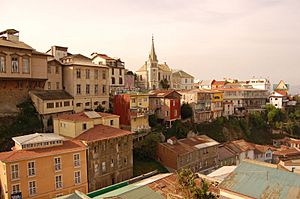
Cerro Concepción
|
|
| Criteria | Cultural: iii |
| Inscription | 2003 (27th Session) |
| Area | 23.2 ha |
| Buffer zone | 44.5 ha |
Valparaíso is called "The Jewel of the Pacific." It became a World Heritage Site because of its unique city design and architecture. In 1996, its special funicular lifts were called one of the world's most endangered historical treasures. In 2003, Valparaíso was officially named a World Heritage Site. The city is built on many steep hills overlooking the Pacific Ocean. It has a maze of streets and cobblestone alleys, full of amazing buildings and culture.
Since becoming a World Heritage Site, Valparaíso has made changes to keep its cultural history alive.
Some famous places in Valparaíso include:
- Iglesia de la Matriz
- Plaza Aníbal Pinto
- Plaza Sotomayor (which includes the Edificio Armada de Chile)
- 16 remaining funiculars (called ascensores). Most are public and are national monuments.
- The historic areas of Concepcion and Alegre hills.
- Bellavista hill, which has an "open air museum" with murals.
- Monuments to important historical figures.
- Cemeteries on Panteón Hill.
Gallery
Who Lives in Valparaíso?
Valparaíso is Chile's sixth largest city. Its urban area has about 263,499 people. However, the Greater Valparaíso area, which includes nearby cities like Viña del Mar, is the second largest in the country with over 800,000 people.
People who live in Valparaíso are called porteños (for males) or porteñas (for females). This means "port dweller" in Spanish.
Valparaíso's Economy
The main industries in Valparaíso are tourism, culture, shipping, and moving goods.
About 50 international cruise ships visit Valparaíso during the four-month Chilean summer. The port is also a key place for shipping containers. It exports many products, such as wine, copper, and fresh fruit.
Getting Around Valparaíso
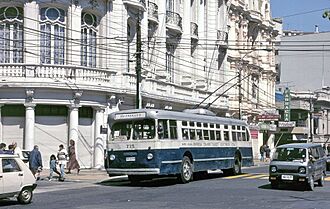
A commuter rail service called the Valparaíso Metro opened in 2005. It connects Valparaíso's city center with Viña del Mar and other towns. It is the second underground train system in Chile.
Buses, trolleybuses, and funiculars are the main ways to get around Valparaíso. Buses offer regular service to the city center and the many hills where people live. The Valparaíso trolleybus system has been running since 1952. Some of its original vehicles from 1952 are still used today! These are the oldest trolleybuses still in regular service anywhere in the world. They were named National Historic Monuments in 2003.
Roads in Valparaíso are getting better. A new highway helps trucks go straight to the port without driving through busy downtown streets. Traveling between Valparaíso and Santiago takes about 80 minutes on a modern highway.
Most foreign visitors arrive by flying into Santiago or by cruise ship.
Funiculars: Hillside Elevators
Because of the steep hills, many areas of Valparaíso are hard to reach by regular transport. This is where the "elevators" come in handy! They connect the upper parts of the city with the lower "plan" area. The only true vertical elevator is the Ascensor Polanco. The others are more like cable cars, but everyone calls them elevators. The first one, Ascensor Concepción, opened in 1883 and still works today.
Many of Valparaíso's funiculars (called ascensores) are considered Historical Monuments. As part of its UNESCO World Heritage Site status, Valparaíso has promised to fix and maintain these important cultural landmarks.
How People Travel in Valparaíso
On average, people spend about 68 minutes traveling with public transport in Valparaíso and Viña del Mar on a weekday. About 15% of riders travel for more than 2 hours each day. People usually wait about 13 minutes at a stop. The average distance for one trip on public transport is 7 kilometers (4.3 miles).
Valparaíso's Port
The port of Valparaíso is divided into ten areas. It is the main port for containers and passengers in Chile. It handles 10 million tons of goods each year and welcomes about 50 cruise ships and 150,000 passengers.
Valparaíso's Culture
During its "golden age" (1848–1914), Valparaíso welcomed many immigrants, mostly from Europe. These groups left their mark on the city's unique buildings. Each community built its own churches and schools. The biggest groups came from Britain, Germany, and Italy. They each created their own hillside neighborhoods, which are now protected as historic areas.
In the late 1900s, Valparaíso faced hard times. Many rich families moved away. By the early 1990s, much of the city's special history seemed lost. But in the mid-1990s, people started working to save the city. Today, you can see many murals created by graffiti artists on the streets and stairs.
The Fundación Valparaíso (Valparaíso Foundation) helps improve neighborhoods and tourist areas. It also runs the city's jazz, ethnic music, and opera festivals.
Valparaíso's newspaper, El Mercurio de Valparaíso, is the oldest Spanish-language newspaper still being printed in the world.
The Fundacion LUKAS keeps the drawings and paintings of a famous cartoonist named Renzo Antonio Giovanni Pecchenino Raggi, known as LUKAS. His work became a symbol of Valparaíso.
Valparaíso also has the "School of Valparaíso," which is part of the Pontificia Universidad Católica de Valparaíso. This school was known for its experimental architecture in the 1960s and 1970s.
Every year, Valparaíso hosts a huge festival on the last three days of December. It ends with a "New Year's by the Sea" fireworks show. This is the biggest fireworks display in Latin America! A million tourists come to watch it along the coast.
In 2003, the Chilean Congress named Valparaíso "Chile's Cultural Capital." It is also home to the nation's new cultural ministry.
Valparaíso has many fun nightlife activities. You can find traditional bars and nightclubs near Plaza Sotomayor.
Sports in Valparaíso
Valparaíso has several public sports places and facilities, including bike paths.
- The Club Deportivo Playa Ancha (Playa Ancha Sports Club) has football fields, basketball and tennis courts, and swimming pools.
- The Complejo Deportivo Escuela Naval (Naval School Sports Centre) has modern facilities for swimming, volleyball, basketball, and more.
- The Estadio Elías Figueroa Brander is a stadium with ties to the local football team, Santiago Wanderers. It holds 18,500 people.
- Fortín Prat is a historic basketball place. It also hosts boxing and other sports.
- The Muelle Deportivo Curauma is a water sports center at Lake Pañuelas. You can go rowing, kayaking, and fishing there.
- The Puerto Deportivo Valparaíso offers sailing, kayaking, and scuba diving lessons. It also promotes eco-tourism in Valparaíso Bay.
- The Velódromo Roberto Parra has a cycle track and courts for other sports.
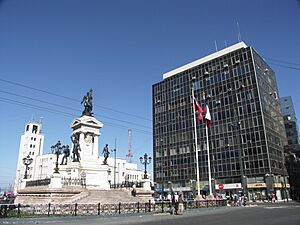
The "Valparaíso Downhill" is a mountain bike race in February. Riders race through the city streets, going down steps and alleys. It's known as a very exciting urban downhill race.
Since 2005, there have been running events in the city, including marathons. The race starts at Muelle Barón and goes along the seafront.
The final part of the 2014 Dakar Rally ended in Valparaíso's Plaza Sotomayor.
Education in Valparaíso
Valparaíso has many schools and universities.
Schools in Valparaíso
Some well-known primary schools include the Liceo Eduardo de la Barra and Salesian College Valparaíso. Many schools are in the city center, especially in the Almendral neighborhood.
Many private schools were started by European immigrants. These include the German School, the Alliance Francaise, and the College of the Sacred Hearts of Valparaíso, which opened in 1837 and is the oldest private school in South America.
Universities in Valparaíso
Valparaíso has many higher education institutions. Some of the most important universities in Chile are here, like the Pontifical Catholic University of Valparaíso, the University of Valparaíso, the Playa Ancha University, and the Federico Santa María Technical University. The main building of the Federico Santa María Technical University is easy to see from many parts of the city.
| University | Started | Short Name | Type | |
|---|---|---|---|---|
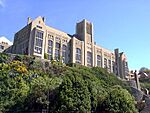 |
Federico Santa María Technical University | 1931 | UTFSM/USM | Private university
Traditional |
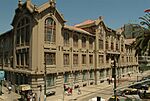 |
Pontifical Catholic University of Valparaíso | 1925 | UCV/PUCV | Private university
Traditional |
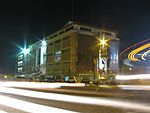 |
Playa Ancha University of Educational Sciences | 1948 | UPLA | Public university |
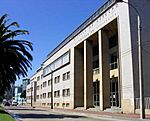 |
University of Valparaíso | 1981 | UV | Public university |
Famous People from Valparaíso
Many important people were born in Valparaíso, including:
- Augusto Pinochet, a general and former leader of Chile
- Camilo Mori, a Chilean painter
- Roberto Ampuero, an author and former Foreign Minister of Chile
- Giancarlo Monsalve, an international opera singer
- Sergio Badilla Castillo, a Chilean poet
- José Maza Sancho, a Chilean astronomer
Many writers have also lived here, such as the Chilean poet Pablo Neruda and the Nicaraguan poet Rubén Darío.
Sister Cities of Valparaíso
Valparaíso is connected with many cities around the world:
 Badalona, Spain
Badalona, Spain Barcelona, Spain
Barcelona, Spain Bat Yam, Israel
Bat Yam, Israel Busan, South Korea
Busan, South Korea Callao, Peru
Callao, Peru Córdoba, Argentina
Córdoba, Argentina Guangzhou, China
Guangzhou, China Havana, Cuba
Havana, Cuba Long Beach, United States
Long Beach, United States Malacca, Malaysia
Malacca, Malaysia Manzanillo, Mexico
Manzanillo, Mexico Medellín, Colombia
Medellín, Colombia Novorossiysk, Russia
Novorossiysk, Russia Oviedo, Spain
Oviedo, Spain Rosario, Argentina
Rosario, Argentina Salvador, Brazil
Salvador, Brazil Santa Fe, Spain
Santa Fe, Spain Shanghai, China
Shanghai, China Veracruz, Mexico
Veracruz, Mexico
Valparaíso also works with:
 Basel, Switzerland
Basel, Switzerland Odesa, Ukraine
Odesa, Ukraine San Francisco, United States
San Francisco, United States
See also
 In Spanish: Valparaíso para niños
In Spanish: Valparaíso para niños


